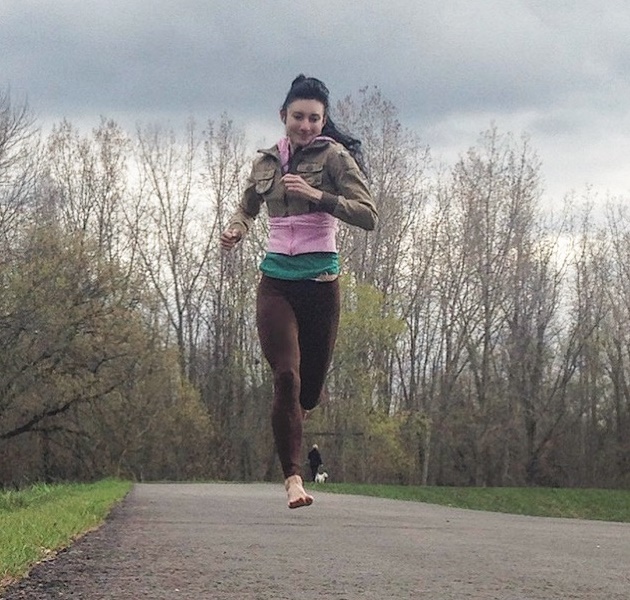Running without shoes with a forefoot strike may actually give you enough cushioning to avoid a shin bone fracture as compared with heel strike running in thick cushioned running shoes.
How can running without shoes potentially help you avoid the fate of getting a shin bone fracture? Running barefoot naturally strengthening the foot/ankle complex, ensuring enough layers of impact protection on the shin bone.
Why running shoes don’t always provide enough impact protection to defend against a shin bone break during running? Cushioned running shoes may significantly weaken the feet and ankles, leaving the shin bone wide open to high impact forces during running.
According to Pamucoff and Blackburn (2015), a weak and stiff ankle coupled with a high ground reaction force (as seen in heel strike runners who run in standard running shoes) prevents the lower leg from adequately absorbing shock during running and therefore, may contribute to a shin fracture injury.
Moreover, weak and stiff plantarflexors (the plantarflexors are a group of muscles integrated throughout the top of the foot and extend up the leg) were found to be another contributor to tibial stress fracture development in runners
- Weak plantarflexors may be a by-product of running in cushioned running shoes while utilizing a heel strike landing as compared with running barefoot with a forefoot strike landing. Many heel strike runners don’t fully utilize their plantarfelxors as much as forefoot runners as heel strike runners typically use their dorsiflexors (another group of muscles within the foot that links up into the lower leg) to help pull the forefoot back to initiate heel strike during heel strike running.
- When the ankle and plantarflexor muscles are weak, each foot strike during running may become more stressful on the shin bone, which may raise the possibility of a stress fracture injury.
- If ankle and plantarflexor strength is lacking, there may be a lack of cushioning on the shin bone when a runner runs with a forceful heel strike landing pattern (because the ground reaction force is greater), thus more impact may shoot through the shin bone.
To make matters worse, most runners typically wear thick cushioned running shoes for impact protection during running, but research now shows that the thicker the cushioning under the foot, the harder the runner strikes the ground with their foot, therefore more stress may be projected on the shin bone. So what is a runner to do to keep tibial stress fractures at bay? The answer is barefoot running.

Running Without Shoes May Prevent Shin Fracture
Researchers have been hard pressed to explain the core risk factors for a tibia stress fracture (shin bone fracture) in runners. However, not all runners are equally vulnerable to a tibial stress fracture. Barefoot runners, for example, are well-known for landing with a forefoot strike and for having stronger feet and ankle, and may have a reduced risk of a shin bone fracture injury as compared to habitual shod runners who heel strike during running. This is because running barefoot may evoke favorable mechanical responses due to the hyper-activation and stimulation of the nerves in the bottom of the feet which may dramatically improve proprioception (body position/posture/movement awareness) and may reduce the bad habits of running in cushioned heeled running shoes, resulting in a less intense ground reaction force. More meaningful results from running barefoot are stronger feet and ankles, as well.
- Let me point out that research is beginning to reveal the multiple ways that going barefoot promotes positive, immediate changes in neuromuscular function and strength, especially in the foot/ankle, that may help protect the tibia during running.
When you run barefoot, you typically avoid mis-aligning your foot and ankle posture at touchdown as an attempt to make the ground feel softer on your feet. In doing so, you tend to land more forefooted (towards the front part of your foot) which recruits greater plantarflexor activity and ankle demands as compared with landing with a heel strike. This is how running barefoot may consistently keep the foot/ankle complex strong, ensuring greater shock protection on the tibia.
- It turns out that neuromuscular electrical stimulation automatically improves isometric strength while reducing muscle stiffness (Grosset et al., 2014).
- Even more important, proprioceptive neuromuscular facilitation exercises improves and maintains plantarflexor strength (Konrad et al. 2014), suggesting that environments that boost proprioception via increased nerve stimulation on the feet (like going barefoot) may increase the functional activity and strength of the plantarflexors and ankles, which may have protective effects on the shin bone during running–remember, strong, able-functioning plantarflexors may help keep impact low on the shin bone during running.
- Going barefoot may be the best way to boost proprioception (limb position sense) because barefoot activity increases the flow of sensory information to the sensory nerves in the feet which communicate to the sensory nerves in the ankle, knee and hip and most importantly, to the central nervous system. This type of sensory information flow includes changes in foot position/strike and changes in balance (Hohne et al. 2011), to enable a softer landing in a form of a forefoot strike over a forceful heel strike when running shoeless.
- To keep impact low, running barefoot most often prompts a forefoot strike landing which may keep the plantarflexor and ankle muscles more actively engaged, thereby possibly transferring less impact shock to the shin bone as stronger foot/ankle muscles may be better able to soak up more impact.
What is more, since running barefoot expands the range of nerve activation in the feet, may also activate a range of neuromuscular responses and reflexes that may help keep the ground reaction force at a much lower magnitude as compared to running in thick, cushioned running (such shoes reduces sensory input in the feet) making it easier to develop more forceful mechanical habits (in the form of heel striking).
Therefore, for safe, low-impact running, the body may strongly depend on sensory information, starting at the feet, for its movement safety and to prevent balance impairments. In addition, more studies have found that increasing proprioceptive feedback at the feet via barefooting, may turn-down injury by allowing better movement smoothness (i.e. safer interaction of the body with the ground via a forefoot strike landing), enhanced movement coordination as well as better functional stability of the ankle and foot joints. In summary, when proprioception is strong at the feet, foot/ankle joint function and stability strengthens, thus stress factors on the shin during running may be greatly reduced. AND remember, you get full-fledged proprioception when you are barefoot.
- A running-related tibial stress fracture may occur when proprioception is blocked at the feet because a lack of sensory information integration at the feet may lead to ineffective muscle forces, disturbed posture, and a motor response delay in the peroneal muscle, resulting in overall poor ankle movement and force amplification up the leg.
- Cushioned running shoes may reduce the sensory mechanisms that mediate platnarflexor and ankle strength and a wealth of studies show that barefooters display higher levels of sensory input/nerve stimulation at the feet than runners who wear thick cushioned running shoes.
- Exposure of the bare foot to the environment during running unleashes different stimuli that not only helps trigger a forefoot strike landing (and a lower ground reaction force), this high volume of sensory stimulation acting on the bottom of the feet during barefoot running appears to manifests themselves in way that involves a more concentrated engagement of the ankle muscles and the plantarflexors as well as high-impact avoidance actions of the leg.
Overall, running barefoot may be an ideal tactical method to correct ankle and foot strike mechanics and to automatically strengthen foot and ankle muscles to ensure less impact penetrates the shins during forefoot running.
Remember, the only source of exceptional proprioceptive input is barefooting as it has the power to activate the key nerves in the feet rooted in controlling safe, efficient biomechanics. Don’t make the mistake I made in that when I first transitioned from heel strike to forefoot strike running, I did so wearing regular running shoes. I did not go barefoot. As a consequence, I ended up with two fractures on my tibial shaft –not at the same time.
- When you run barefoot, you are, in an evolutionary sense, programmed to reduce impact naturally by landing on the forefoot first, not the heel. This landing pattern modification (switching from a heel strike to forefoot strike) when running barefoot is protective.
- Landing with a forefoot strike also employs greater use of the plantarflexor muscles and ankle muscles at touchdown which can fundamentally alter and reduce impact on the shin bone, providing added layers of impact absorption on the leg.
References:
Arnold, B. L., Linens, S. W., de la Motte, S. J., & Ross, S. E. (2009). Concentric evertor strength differences and functional ankle instability: a meta-analysis. Journal of Athletic Training, 44, 653e662.
Batson, G. (2009). Update on proprioception: considerations for dance education. Journal of Dance Medicine & Science, 13, 35e41.
Grosset JF, Canon F, Perot C, Lambertz D. Changes in contractile and elastic properties of the triceps surae muscle induced by neuromuscular electrical stimulation training. Eur J Appl Physiol. 2014;114(7):1403–
1411.
Hiller, C. E., Refshauge, K. M., & Beard, D. J. (2004). Sensorimotor control is impaired in dancers with functional ankle instability. American Journal of Sports Medicine, 32, 216e223.
Hohne, A., Stark, C., Brüggemann, G. P., & Arampatzis, A. (2011). Effects of reduced plantar cutaneous afferent feedback on locomotor adjustments in dynamic stability during perturbed walking. Journal of Biomechanics, 11(44), 2194e2200.
Hrysomallis, C. (2007). Relationship between balance ability, training and sports injury risk. Sports Medicine, 37, 547e556.
Hrysomallis, C. (2011). Balance ability and athletic performance. Sports Medicine, 1(41), 221e232.
Konrad A, Gad M, Tilp M. Effect of PNF stretching training on the properties of human muscle and tendon structures. Scand J Med Sci Sports. 2014[Epub ahead of print]
Pamukoff DN and TJ Blackburn. Comparison of Plantar Flexor Musculotendinous Stiffness, Geometry, and Architecture in Male Runners With and Without a History of Tibial Stress Fracture, J Appl Biomech, 2015; 31, 41-47.
You can also support Run Forefoot and help keep it going in full force by making a donation in any amount of your choosing: https://www.paypal.me/RunForefoot
Bretta Riches
BSc Neurobiology; MSc Biomechanics candidate, ultra minimalist runner & founder of RunForefoot. I was a heel striker, always injured. I was inspired by the great Tirunesh Dibaba to try forefoot running. Now, I'm injury free. This is why I launched Run Forefoot, to advocate the health & performance benefits of forefoot running and to raise awareness on the dangers of heel striking, because the world needs to know.
Latest posts by Bretta Riches (see all)
- Are Minimalist Shoes Good for Seniors? YES! - 14/04/2024
- BIG Deals On Running Gear And More! - 09/04/2024
- Why Are My Feet Tired After Running? - 04/04/2024


